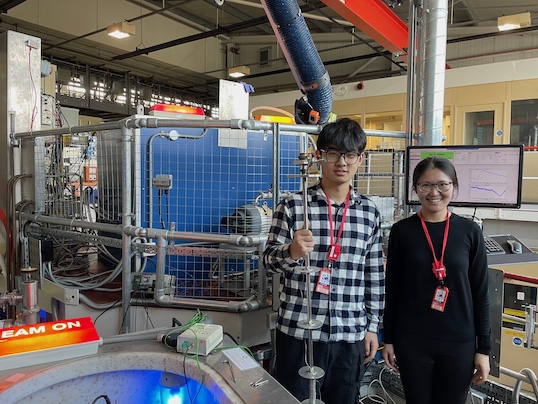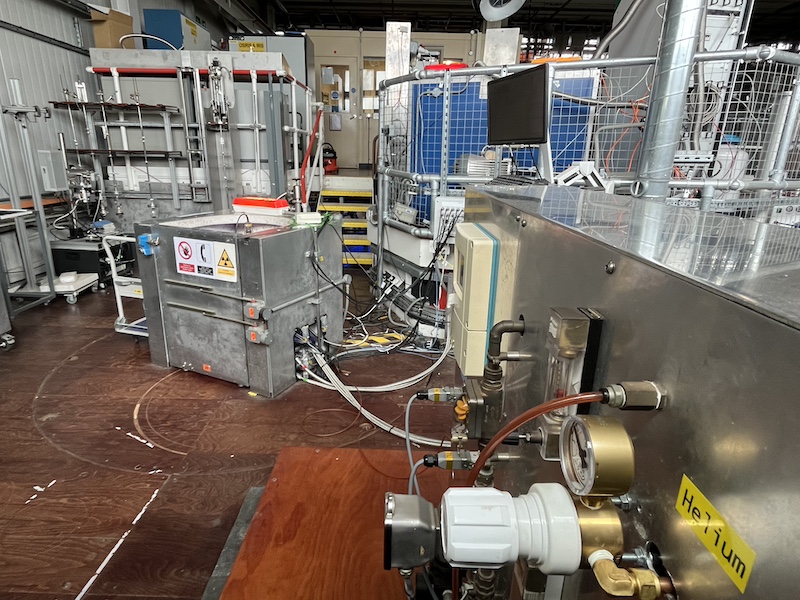
The QENS BAG:
The EXAFS (B18) BAG (bulk allocation group) at Diamond has performed incredibly well, and we are pleased to announce a similar Quasi-Elastic Neutron Scattering (QENS) BAG at ISIS. We are keen to encourage users with no experience of QENS and will provide support throughout the process, from proposal writing through to data interpretation and publishing. QENS is a powerful tool in catalysis research, although currently underused. To reduce the barrier to entry, proposals will be assessed by an internal Hub panel with a lighter touch than that required for a direct proposal to ISIS.
The criteria used to assess these applications will be:
- Previous experience with the technique (with priority given to new users)
- Scientific merit
- Feasibility
- Maximising efficiency
Time will be regularly allocated on the IRIS QENS spectrometer for Catalysis Hub affiliates. Widening the user base on B18 has been one of the great successes of the Diamond BAG. We hope to do the same with QENS at ISIS.
We will run a number of short experiments (1 day max) in the time available. Travel and subsistence will be provided for one user per experiment. They will be expected to stay for the full duration as part of the experimental team that will run all of the experiments for all of the users.

What can Quasi-Elastic Neutron Scattering do for me?
QENS experiments fire a beam of neutrons onto a sample, and then measures how they are scattered. By measuring the energy and momentum changes that occur, we can infer the rate and geometry of motions that are happening in the sample. At IRIS (https://www.isis.stfc.ac.uk/Pages/iris.aspx) in the most common configuration we measure motions with time scales 0.02 – 1.5 ps and length scales of 3 – 15 Å.
QENS can be used to measure amongst others:
- Diffusion in confined materials such as zeolites, polymers and ionic liquids
- Hydrogen storage materials, organic photovoltaics
- Protein structure-dynamic relationships
- Phase transitions
As the interaction between neutrons and matter is simple, molecular dynamics simulations are highly complementary. Trajectories can be simply converted to neutron observables for comparison, which can be used both for refining theoretical models, and in data interpretation.
Measurements
Fixed window scans
Neutrons scattering from moving particles can exchange energy. The faster the motion, the higher the possible energy change. If we imagine a static sample, only elastic collisions are possible. As motion increases, the elastic intensity drops, and the inelastic intensity increases. A simple and sensitive experiment determines is to measure the drop in elastic intensity as a function of temperature. A thin energy slice around zero is integrated and this is referred to as an Elastic fixed-window scan (EFWS). This is not quantitative but indicates under which conditions a motion is activated. Similarly, an inelastic fixed-window scan (IFWS) can be measured, where the integrated range is at a specified energy. Fixed window scans are popular as they are fast whilst still allowing a reasonable level of interpretation. Phase transition temperatures, Debye-Waller information and molecular rigidity can be rapidly obtained. With more involved analysis it may be possible to obtain mobile fractions, geometry of motion and activation energies.
Full scans
A full description of how a sample scatters neutrons is obtained with the dynamic structure factor, S(Q,ω). This describes the probability of a scattered neutron having a particular momentum transfer vector, Q and energy transfer ω, or E. A full scan requires longer data acquisition but can resolve processes not visible with fixed window scans. The mechanisms of long-range diffusion can be interpreted and quantitative diffusion rates obtained.
Quasi-Elastic Neutron Scattering (QENS) measures low energy dynamics from condensed systems, predominantly corresponding to diffusive motions, rotations and re-orientations. Due to the fact that hydrogen scatters neutrons particularly well, almost all work measures the motion of hydrogen-containing material. This can be in mixed systems, such as hydrocarbons sorbed inside zeolite pores or pure materials, such as hybrid perovskites.
Practicalities
Neutrons interact weakly with matter, so larger samples are generally needed than for other techniques. Standard sample containers hold 0.3 – 7.6 cm3. The strength of scattering from different nuclides varies apparently randomly, such that the measurement strongly depends on the species present. Hydrogen scatters particularly strongly, so QENS is well suited to the measurement of organic species. Deuterium, however, has very different scattering characteristics.
A typical elastic fixed window scan will record for c. 10 minutes at a number of temperature points. A full QENS scan will take a few hours.
Some examples of samples commonly studied are proteins, polymers, ionic liquids and hydrogen storage materials. With a sufficient surface area, surface dynamics may also be studied. An ideal sample scatters 10% of the incident neutrons, which is easily determined for a sample with known composition. Materials can be run at a range of temperatures, most commonly from 5–600 K and pressures from UHV to kilobar, though low pressures are preferred. Neutrons interact weakly with matter, so a larger sample is needed than for most techniques. This can vary from 50 mg for a purely organic material to a few grams of sorbate when measuring confined organic species.
For discussion, please contact ian.silverwood@stfc.ac.uk
A Call for proposals is now open and will Close 4th July at 12.00 noon. Please note the experiment will be in the August -October cycle with dates TBC.
To submit a proposal, please fill out the Form (here).
If you have any queries please contact Hub Manager Dr Josie Goodall josie.goodall@rc-harwell.ac.uk and use the Subject line QENS BAG
Webinar
Watch a webinar on the QENS Bag with Dr. Ian Silverwood, UKRI STFC ISIS Neutron and Muon Source, which provides information on the benefits, process and how to apply for the BAG.
Watch the webinar with the link below:
Further reading:
Introduction to Quasielastic Neutron Scattering, J.P. Embs, F. Juryani, R. Hempelmann, Z. Phys. Chem 224 (2010) 5-32, https://doi.org/10.3929/ethz-b-000023188
Quasi-elastic neutron scattering and molecular dynamics simulation as complementary techniques for studying diffusion in zeolites., H. Jobic and D.N. Theodorou, Micropor. Mesopor, Mater, 102 21 (2007), https://doi.org/10.1016/j.micromeso.2006.12.034
A Practical Guide to Quasi-Elastic Neutron Scattering, M.F. Telling, RSC publishing (2020), https://doi.org/10.1039/9781839169090




